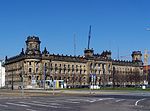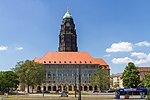German Hygiene Museum
1912 establishments in GermanyMedical and health organisations based in SaxonyMedical museums in GermanyMuseums established in 1912Museums in Dresden

The German Hygiene Museum (German: Deutsches Hygiene-Museum) is a medical museum in Dresden, Germany. It conceives itself today as a "forum for science, culture and society". It is a popular venue for events and exhibitions, and is among the most visited museums in Dresden, with around 280,000 visitors per year.
Excerpt from the Wikipedia article German Hygiene Museum (License: CC BY-SA 3.0, Authors, Images).German Hygiene Museum
Lingnerplatz, Dresden Innere Altstadt (Altstadt)
Geographical coordinates (GPS) Address Phone number Website External links Nearby Places Show on map
Geographical coordinates (GPS)
| Latitude | Longitude |
|---|---|
| N 51.044166666667 ° | E 13.746666666667 ° |
Address
Deutsches Hygiene-Museum
Lingnerplatz 1
01069 Dresden, Innere Altstadt (Altstadt)
Saxony, Germany
Open on Google Maps










